خانه شریفیها
دفتر معماری دیگر (علیرضا تغابنی)
موقعیت: تهران، ایران
تاریخ: ۱۳۹۲
مساحت: ۱۴۰۰ مترمربع
وضعیت: ساختهشده
کارفرما: مژگان زارع نیری، فرشاد شریفی نیکآبادی
طراح: علیرضا تغابنی
همکاران طراحی: روحالله رسولی، فریده آقامحمدی
فاز دو: دفتر باحور (حمید محمدی، امیر طالشی)
مشاور ارشد فاز دو و تهیه نقشههای کارگاهی: شهناز گوهربخش
همکاران پروژه: مجتبی مرادی، نگار رهنمازاده، عسل کرمی، مجید جهانگیری، مسعود ساقی، حسین نقوی، فاطمه طباطبائیان، ایمان جلیلوند
نظارت: شهناز گوهربخش، علیرضا تغابنی
طراح سازه: سهراب فلاحی
طراح تاسیسات مکانیکی: هوفر اسماعیلی
طراح تاسیسات برقی: محمد ترکمانی
مشاور فضای سبز: بابک مستوفی صدری، امید عباس فردی
مجری: شرکت ایمن سازه فدک (داوود دوستمحمدی، محمدرضا بهداد، امیر حجازی، محسن شمشیری)
سیستم اتاقهای گردان: شرکت بومات
مجسمهساز: محمدرضا حکیمی
نقاش: شهلا همایونی
عکس: پرهام تقیاف، سالار مطهری
جوایز: رتبه اول گروه مسکونی جایزه معمار ۱۳۹۲
خانه شریفیها در هفت طبقه طراحی شده که طبقات زیرزمین آن به فعالیتهای ورزشی و تفریحی، طبقه همکف به پارکینگها و واحد سرایداری، طبقات اول و دوم به عملکردهای عمومی، و طبقات سوم و چهارم به اتاقهای خواب اختصاص داده شده است.
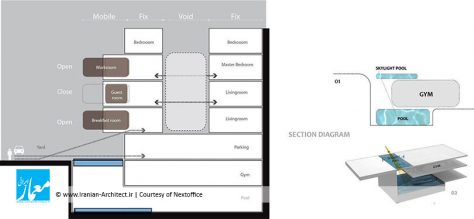
در خانه شریفیها، چالش با مفاهیم گونههای درونگرا / برونگرا، راهگشای پروژه برای حرکت به سوی طرحی متغیر و هیجانانگیز در فرم و فضا شد. مشخصه اصلی این پروژه، انعطافپذیری و غیرقطعیت است، به طوری که با حرکت اتاقهای چرخان، کیفیت فضای داخلی و فرم بیرونی، به طور مداوم تغییر میکند و به باز و بسته شدن / درونگرا و برونگرا شدن پروژه میانجامد. این تغییرات در فصلهای مختلف یا در سناریوهای متنوع عملکردی میتواند مورد استفاده قرار بگیرد.
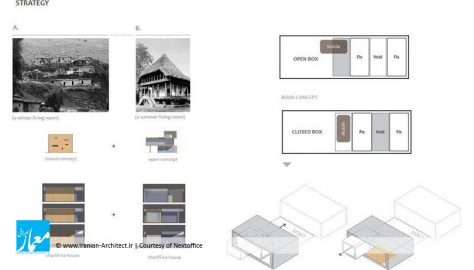
زمین پروژه، مانند بسیاری از بلوکهای شهری، به رغم عمق زیاد، بر و نمای محدودی داشت. بنابراین تبدیل نمای دوبعدی به حجم سهبعدی، در این پروژه شکلی عمیقتر به خود گرفت و سعی شد ساختمان با این باز و بسته شدن، مانند خانههای قدیمی، امکان زمستاننشین شدن و تابستاننشین شدن را داشته باشد که در تابستان حجمی باز و شفاف و پر از خلل و فرج و دارای تراسهای عمیق و بزرگ باشد و در زمستانها که تراس در تهران کمتر به کار میآید، حجمی بسته، بدون تراس و با حداقل بازشو.
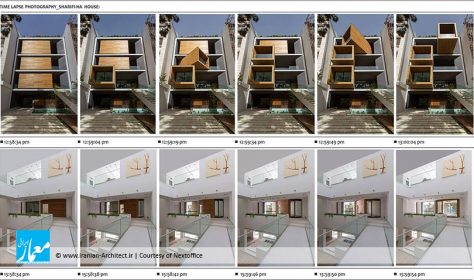
در خانه شریفیها، نوع استفاده از فضاها امکانهای متفاوتی میتواند به استفادهکننده بدهد. به طور مثال، اتاق مهمان در طبقه دوم، با حضور یا عدم حضور مهمان، میتواند تغییر شکل دهد و یا اتاقهای کار و فضاهای صبحانهخوری (اتاقهای گردان طبقات سه و یک)، بر اساس نوع عملکرد و خواست استفادهکنندگان، میتوانند تغییر حالت دهند. به عبارت دیگر، امکان ایجاد سناریوهای مختلف فصلی یا نوری برای فضاها وجود دارد که بعضی از آنها هماکنون در برنامه BMS پروژه دیده شده است.
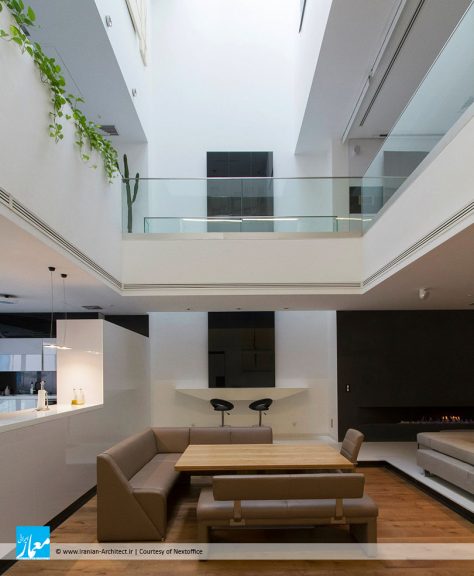
خانه شریفیها از چهار قسمت در سازماندهی پلان تشکیل شده که به ترتیب، قسمت ثابت (Fix) / قسمت خالی (Void) / قسمت ثابت (Fix) / قسمت متحرک (Mobile) هستند. هنگام بسته بودن اتاقهای گردان، نورگیری ساختمان از فضای خالی مرکزی است و ارتباط بین دو قسمت، با پلهایی معلق در فضای خالی مرکزی صورت میگیرد.
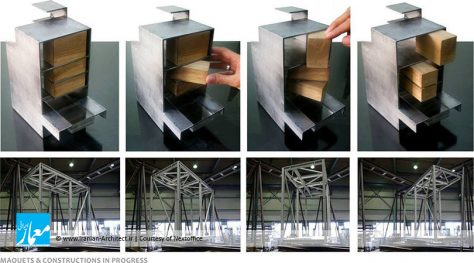
تکنیک ساخت سیستم چرخش این پروژه بسیار ساده بود، همان که در سن تئاترهای گردان، نمایشگاههای اتومبیل، صنعت ذوبآهن و کشتیرانی موجود است. سازندگانش هم در داخل ایران زیاد بودند، اما به دلیل اینکه کارفرما واردکننده ماشینهای صنعتی و CNC چوببری از آلمان بود، ترجیح داد این سیستم در آلمان طراحی و ساخته شود و چند نفر از کارکنان هم آموزشهای لازم برای نگهداری سیستم در آینده را ببینند. از چالشهای پروژه، نرده و هوابندی اتاقهای چرخان بود که با تا شدن نردهها و همچنین با تغییراتی در لبه جعبهها و کنار پنجرهها، مسئله هوابندی حل شد.
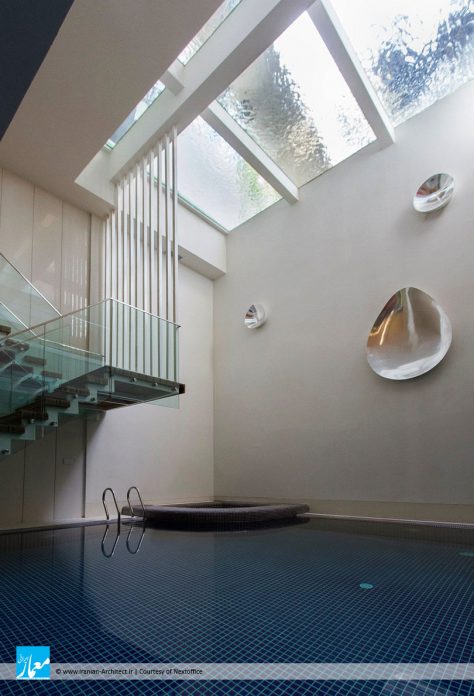
در اتودهای اولیه سعی شده بود هر کدام از سه اتاق گردان روبهروی سه درخت کاج تهران بلندی که در سایت وجود دارند، باز شوند. در نهایت نیز، اتاقها در حالت باز درختها را قاب میکنند. همچنین عقبنشینی سه متری از حد مجاز باعث شد بتوانیم برای دو طبقه ورزشی و استخر در زیرزمین، از آبنمایی شیشهای نورگیری کنیم. فضاهای ورزشی در مقطع بین دو حوضچه تعریف شدهاند که به وسیله مجسمههای آیینهای، تلالوی این دو حوضچه را در خود منعکس میکنند.
Sharifi-ha House
Nextoffice (Alireza Taghaboni)
Location: Tehran, Iran
Date: 2013
Area: 1400 sqm
Status: Completed
Client: Mojgan Zare Nayeri, Farshad Sharifi Nikabadi
Design: Alireza Taghaboni
Design Associates: Roohollah Rasooli, Farideh Aghamohammadi
Detailing Design: Bahoor Office (Hamid Mohammadi, Amir Taleshi)
Detailing Design Consultant: Shahnaz Goharbakhsh
Project Associates: Mojtaba Moradi, Negar Rahnemazadeh, Asal Karami, Majid Jahangiri, Masoud Saghi, Hossein Naghavi, Fatemeh Tabatabaeian, Iman Jalilvand
Supervision: Shahnaz Goharbakhsh, Alireza Taghaboni
Structural Design : Sohrab Falahi
Mechanical Consultant: Hoofar Esmaeili
Electrical Consultant: Mohammad Torkamani
Landscape Consultant: Babak Mostofi Sadri, Omid Abbas Fardi
Construction: Imen Sazeh Fadak Co. (Davood Doostmohammadi, Mohammadreza Behdad, Amir Hejazi, Mohsen Shamshiri)
Revolving Rooms System: Bumat Company
Sculptor: Mohammadreza Hakimi
Painting: Shahla Homayouni
Photo: Parham Taghioff, Salar Motahari
Awards: 1st Place of Memar Award 1392
The House is distributed over seven floors: the two basement floors are allocated to family conviviality, fitness facilities, and wellness areas, while the ground floor hosts parking and housekeeping rooms. Public activities all happen on the first and second floors, and the family’s private life takes place on the third and fourth floors.
Uncertainty and flexibility lie at the heart of this project’s design concept. The sensational, spatial qualities of the interiors, as well as the formal configuration of its exterior, directly respond to the displacement of turning boxes that lead the building’s volume to become open or closed, introverted or extroverted. These changes may occur according to changing seasons or functional scenarios.
Like many other urban plots, the land for this project had a noticeably narrow façade-width compared with its depth of its length. Consequently, our expertise in transforming a two-dimensional façade to a three-dimensional one became indispensable. Here, the openness / closure of the building’s volume is a reference to traditional Iranian houses, which would dynamically serve as seasonal modes of habitation by offering both a Zemestan-Neshin (a winter living room) and Taabestan-Neshin (a summer living room) to their residents.
In summertime, Sharifi-ha House offers an open / transparent / perforated volume with wide, large terraces. In contrast, during Tehran’s cold snowy winters, the volume closes down, offering minimal openings and a total absence of those wide summer terraces. In this project, the challenges to the concepts of introverted / extroverted typology led to an exciting spatial transformation of an ever-changing residential building.
The house adapts to the functional needs of its users. For instance, depending on whether, there is a guest or not, the guest room (located on the second floor) can be reconfigured for different purposes. Similarly, home offices and breakfast rooms (turning rooms on the first and third floors) can change the formality of their appearance according to their residents’ desires. In the other words, there is always the possibility of having different seasonal or lighting scenarios, some of which have been already considered in the BMS program of the project.
The project consisted of four major parts; the fixed volume of the structure, the void, and the fixed volume and the mobile volume, respectively. When the turning boxes are closed, the building captures sunlight throughout the space of the central void, which also connects the two fixed volumes by suspended bridges.
The applied manufacturing technique for the turning mechanism was in fact a simple one the same method employed in turning theatrical scenes, turning the floor of car exhibitions, and employed by steel companies and the shipping industry in Iran. But as our client himself was into importing CNC and other similar industrial German machines, he preferred the structural system to be fabricated in Germany. In doing so, he could engage his employees in the manufacturing process and thus train them for future maintenance purposes. Details of the handrails and air-penetration controlling methods were major issues considered in developing the design of the turning boxes. Designing foldable handrails and refining the boxes’ edges happened to be our feasible solutions.
From the initial design steps, we noticed that three pine trees outside could be incorporated into the spaces of the interior. Now, in the open mode of the house, the trees are pleasantly captured by the window frames. Stepping back for about three meters from the permitted construction boundary line allowed us to provide splendid daylight for the basement floors by inserting a glass fountain. The fitness and wellness areas are accommodated between the fountain’s two small basins, whose mirrored sculptures reflect the water’s radiance throughout the space.
Considering the specialties of this kind of architecture, the structural system was inevitably irregular. After digitally modeling the structure, a series of SAP2000 analyses were undertaken to examine static / dynamic performance of the proposed system. Being partially moveable is the dominant feature of this structural assembly, which was contemplated throughout the fabrication process by the German manufacturer company. The main loads all rest on the beams of the living rooms. Due to the various configurations the turning boxes may take, the loading calculation has been estimated based on the largest possible loading value applied to the system. Additionally, controlling the probable vibrations to prevent structural deformation in the turning boxes was taken into account during the design of the house.

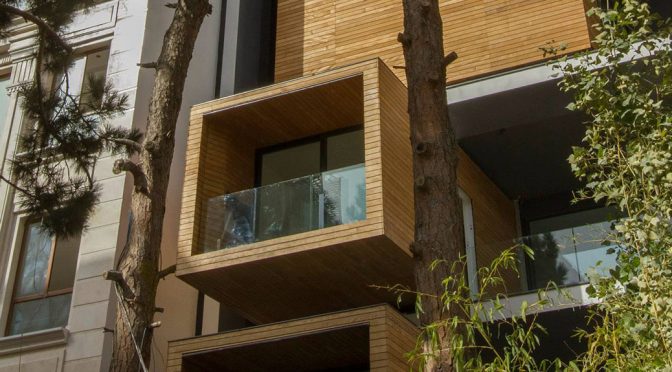
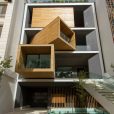
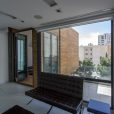
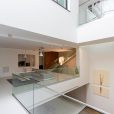
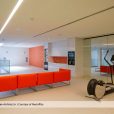
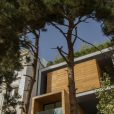
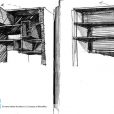
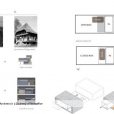

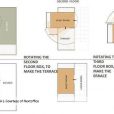
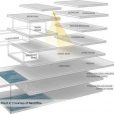
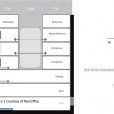
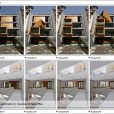
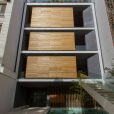
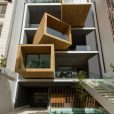
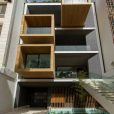
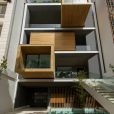
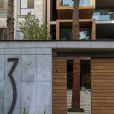
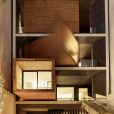
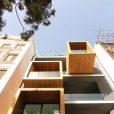
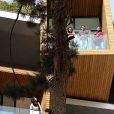
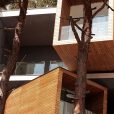
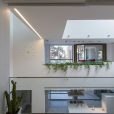
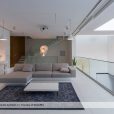
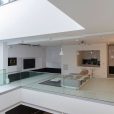
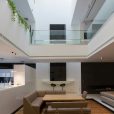
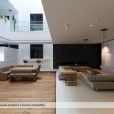
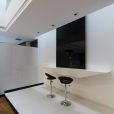
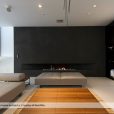
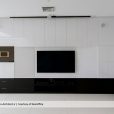
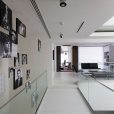
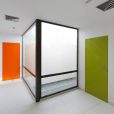
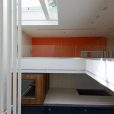
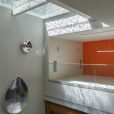
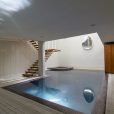
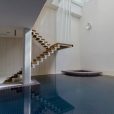
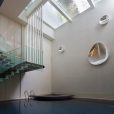
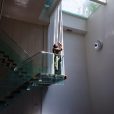
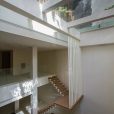
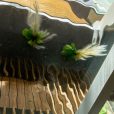
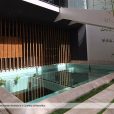
بسیار زیبباست